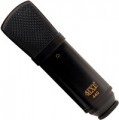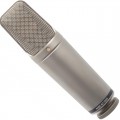Rated resistance
Microphone AC impedance; this parameter is also called "impedance". This is one of the most important characteristics that determines compatibility with the amplifier or other device to which the microphone is connected: if the impedance is not optimal, there may be a loss in signal power. It has its own characteristics, depending on the purpose of a particular model (see above). So, for microphones used with computers, laptops, voice recorders and phones / tablets, the impedance may not be indicated at all — the characteristics of such models are selected in such a way as to ensure normal compatibility with the corresponding devices. But in professional audio equipment, special rules are used for selection; more details can be found in special sources.
Frequency range
The range of audio frequencies normally perceived and processed by a microphone.
The wider this range — the fuller the signal, the less likely that too high or low frequencies will be missed due to the imperfection of the microphone. However, in this case, it is worth considering some nuances. First of all: a wide frequency range in itself does not guarantee high sound quality — a lot also depends on the type of microphone (see above) and its frequency response, not to mention the quality of other components of the audio system. In addition, a large width is also not always really necessary. For example, for normal transmission of human speech, a range of 500 Hz — 2 kHz is considered sufficient, which is much narrower than the general range perceived by the human ear. This general range, in turn, averages from 16 Hz to 22 kHz, and also narrows with age. Do not forget about the features of the equipment to which the microphone is connected: it is hardly worth specifically looking for a model with an extensive range, if, for example, the amplifier to which it is planned to be connected severely “cuts off” the frequencies from above and/or below.
Sound pressure
The maximum sound pressure perceived by the microphone, at which the harmonic oscillation coefficient does not exceed 0.5% — in other words, the highest sound volume at which no noticeable interference occurs.
The higher this indicator, the better the microphone is suitable for working with loud sound. Here it is worth considering that the decibel is a non-linear quantity; in other words, an increase in volume from 10 dB to 20 dB or from 20 to 40 dB does not mean a 2-fold increase in volume. Therefore, when assessing, it is most convenient to refer to comparative tables of noise levels. Here are some examples: a level of 100 dB roughly corresponds to a motorcycle engine or subway car noise; 110 dB — helicopter; 120 dB — the work of a demolition hammer; 130 dB, comparable to the sound of a jet aircraft taking off, is considered a pain threshold for a person. At the same time, many high-end microphones are able to work normally at a sound pressure of 140 – 150 dB — and this is a noise level that can cause physical damage to a person.
Signal to noise ratio
A parameter that describes the relationship between the useful signal level and the noise level produced by the microphone. Note that the actual signal-to-noise ratio varies depending on the sound pressure perceived by the microphone. Therefore, in the characteristics it is customary to indicate the option for a standard situation — at a sound pressure of 94 dB. This allows you to compare different models with each other.
In general, this indicator quite clearly characterizes the quality of work of a particular model, since it takes into account almost all significant extraneous noise that occurs during operation. The greater this ratio, the clearer the sound is, the less distortion it has. Values of 64 – 66 dB are considered quite decent, and high-end microphones provide performance of 72 dB and higher.
Material
The material from which the microphone body is made.
— Plastic. The main advantages of plastic are low cost, light weight and complete insensitivity to corrosion. At the same time, it is considered less reliable than metal, due to its relatively low strength (high-strength varieties of plastics exist, but in the case of microphones, it is usually easier to use metal after all). Therefore, this material is popular mainly among models for which lightness and miniature are important — primarily lapel,
head and those that
are installed on a video camera(see "Destination"). It is also often found in computer and laptop devices, but
plastic microphones for vocals usually belong to the entry-level price category.
— Metal. Metal is more expensive than plastic and has more weight. On the other hand,
metal microphones are much stronger and more reliable, besides, a microphone in such a case gives the impression of "solidity" (not least due to massiveness). This option is popular with mid to high end vocal,
studio and
instrument microphones.

